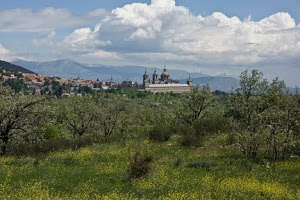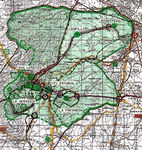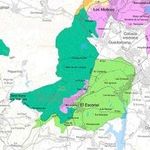Collaborative Design Planting Design Working Group 24: Difference between revisions
| Line 34: | Line 34: | ||
== Landscape and/or urban context of your case == | == Landscape and/or urban context of your case == | ||
*''Biogeography, cultural features, overall character, history and dynamics'' | *''Biogeography, cultural features, overall character, history and dynamics'' | ||
'''History''' | |||
The territory has been hhabitated at least since the Eneolithic time (Copper age), ther is an old settlemnt od that time in the slpes of the machotas mountains, as well as el Deheson, related to the megalithic tombns of Dolden del Rincón and burial state of Canto de Castrejo, among other megalithic tombs on the suroundings. From the Roman time it was found a ''civitas'' near the river banks of Guadarrama, unfar from the today ruins of Monesterio (a Midde Age village and later palace of Philipp II), as well as old roman roads, and a late roman hostels was excabatedrecentñy at the neighbout veillage of Collado Mediano. The old Roman roads where used later during the Visigothic and Arab times, although the Hispanoarabs built new roads crossing the mountains. | |||
During the Arab rule in the early Middle Age there were some scattered Mozarabe small villages. The region was later taken by the knights and settlers from Segovia, taking importance the villages of El Escorial and Navalquejigo, among other smaller places. During the late Middle Age several palaces and towers were built by landlords and kings in the area, as El Campillo, which later were bought, renovated and adapted by Philipp II. Before the Renaissance the economy was based on extensive cattling and family scale agriculture. | |||
In the XVIth. Century, when the Royal Monastery of St. Lawrence at El Escorial was built by Philipp II (the contruction of the 4 Ha building took from 1563 to 1584) the same king decided to enclose the whole Monastery lands and related territories, as well as several already existing or new constructed palaces and mannors, by a 55 km long granite and gneis stone wall(Gran Cerca or Pared Real). It was renovated in 1793. | In the XVIth. Century, when the Royal Monastery of St. Lawrence at El Escorial was built by Philipp II (the contruction of the 4 Ha building took from 1563 to 1584) the same king decided to enclose the whole Monastery lands and related territories, as well as several already existing or new constructed palaces and mannors, by a 55 km long granite and gneis stone wall(Gran Cerca or Pared Real). It was renovated in 1793. | ||
The Monastery and related palaces, mannors and lands inside this historical territory include some of the most relevant renacentist and neoclassical gardens in Spain and the landscape has been an important issue since Philipp II, who was a passionated lover of Nature and gardens, organising mayor planting operations in the mountains in different parts of Spain, and creating gardens and orchards in all his mayor palaces and residencies. | The Monastery and related palaces, mannors and lands inside this historical territory include some of the most relevant renacentist and neoclassical gardens in Spain and the landscape has been an important issue since Philipp II, who was a passionated lover of Nature and gardens, organising mayor planting operations in the mountains in different parts of Spain, and creating gardens and orchards in all his mayor palaces and residencies. | ||
| Line 48: | Line 55: | ||
The lower mountains bear mature forests of Pyrenean oak (''Quercus pyrenaica'') with a rich biodiversity, including a relictics forest of sweet chesnuts (''Castanea sativa''), as well as ''Acer monspessulanum'', ''Corylus avellana'', ''Malus sylvestris'', ''Pyrus bourgaeana'', ''Prunus avium'', ''Prunus spinosa'', ''Rhamnus cathartica'', ''Quercus faginea'', ''Fraxinus angustifolia''. In the lowe lands ther are open porests and groves of ''Quercus ilex'' sp. ''ballota'' and ''Fraxinus angustifolia''. | The lower mountains bear mature forests of Pyrenean oak (''Quercus pyrenaica'') with a rich biodiversity, including a relictics forest of sweet chesnuts (''Castanea sativa''), as well as ''Acer monspessulanum'', ''Corylus avellana'', ''Malus sylvestris'', ''Pyrus bourgaeana'', ''Prunus avium'', ''Prunus spinosa'', ''Rhamnus cathartica'', ''Quercus faginea'', ''Fraxinus angustifolia''. In the lowe lands ther are open porests and groves of ''Quercus ilex'' sp. ''ballota'' and ''Fraxinus angustifolia''. | ||
[http://www.sanlorenzoturismo.org/ingles/entorno_natural/documentos/herreria_flora.pdf Pyrenean oak forests ''Quercus pyrenaica''] | [http://www.sanlorenzoturismo.org/ingles/entorno_natural/documentos/herreria_flora.pdf Pyrenean oak forests ''Quercus pyrenaica''] | ||
'''Landscape''' | |||
<gallery caption="Maps" widths="150px" heights="150px" perrow="4"> | <gallery caption="Maps" widths="150px" heights="150px" perrow="4"> | ||
Revision as of 05:23, 17 January 2014
---> back to group page working group 24
Landscape at the Historical Site of El Escorial (Spain)
| Name | Landscape of the historical Cerca Real (Royal Wall) Territory at El Escorial | |
| Location | El Escorial (Madrid) | |
| Country | Spain | |
| Authors | Francisco Felipe-Martínez, Le Trang Nguyen, Irina Slobozeanu | |

| ||
|
| ||
Landscape and/or urban context of your case
- Biogeography, cultural features, overall character, history and dynamics
History
The territory has been hhabitated at least since the Eneolithic time (Copper age), ther is an old settlemnt od that time in the slpes of the machotas mountains, as well as el Deheson, related to the megalithic tombns of Dolden del Rincón and burial state of Canto de Castrejo, among other megalithic tombs on the suroundings. From the Roman time it was found a civitas near the river banks of Guadarrama, unfar from the today ruins of Monesterio (a Midde Age village and later palace of Philipp II), as well as old roman roads, and a late roman hostels was excabatedrecentñy at the neighbout veillage of Collado Mediano. The old Roman roads where used later during the Visigothic and Arab times, although the Hispanoarabs built new roads crossing the mountains.
During the Arab rule in the early Middle Age there were some scattered Mozarabe small villages. The region was later taken by the knights and settlers from Segovia, taking importance the villages of El Escorial and Navalquejigo, among other smaller places. During the late Middle Age several palaces and towers were built by landlords and kings in the area, as El Campillo, which later were bought, renovated and adapted by Philipp II. Before the Renaissance the economy was based on extensive cattling and family scale agriculture.
In the XVIth. Century, when the Royal Monastery of St. Lawrence at El Escorial was built by Philipp II (the contruction of the 4 Ha building took from 1563 to 1584) the same king decided to enclose the whole Monastery lands and related territories, as well as several already existing or new constructed palaces and mannors, by a 55 km long granite and gneis stone wall(Gran Cerca or Pared Real). It was renovated in 1793. The Monastery and related palaces, mannors and lands inside this historical territory include some of the most relevant renacentist and neoclassical gardens in Spain and the landscape has been an important issue since Philipp II, who was a passionated lover of Nature and gardens, organising mayor planting operations in the mountains in different parts of Spain, and creating gardens and orchards in all his mayor palaces and residencies.
In 1961 a part of it, the Mount Abantos, got the protection figure of Picturesque Landscape. The UNESCO entitled the Royal Monastry and Historical Site of El Escorial as World Heritage Site in 1984; nevertheless, part of the territory had not a real protection and underwent several contructions in the following decades, which has been strongly contested by local and regional ecologist organisations. In 1995 la Herrería oaks, maple, ash-trees and sweet chestnuts forest was declared a Forest of Special Ecological Interest. In 2006 the Regional Government of Madrid entitled the Royal Wall and the whole land, forests, archeological settlements, monuments and gardens within, as Cultural Protected Item (BIC) as Historic Territory. The place is also part of the European Nature 2000 LIC site of the Guadarrama river and is considered a part of the landscape and environmetal buffer zones for the newly aprobed National Park of the Sierra de Guadarrama Summits.
Nature [1]
The territory climbs from the 800 to the 1753 m above the sea (Abantos summit) and includes a wide range of biotops, from wet endorreic areas and lacoons in the lowerlands to grasspastures in the upper part of the mountains. The mountains slopes are characterised by pine forests of several indigenous species (fromthe lower to the higher places: Pinus pinea, P. nigra sp. salzmannii" v. "hispanica, P. pinaster, P. sylvestris sp. iberica including several alloctonous exemplars and groves of P. muga, P. radiata, P. jeffreyi, P. sabiniana and P. culterii) and the related species growing with them, togehter with Juniperus (J. oxycedrus, J. communis, J. alpina nana), very old yew trees (Taxus baccata) and some other exoticals (Larix decidua, Cedrus atlantica, Cedrus libani, Picea abies, Pseudotsuga menziesii, Cupressus × leylandii, all of them planted by the Forestry Engineering School between 1888 and 1914) and decidious trees as Sorbus acucuparia, Amelanchier ovalis',Ulmus laevis, Ulmus nigra and most of the typical of the oaks forest,entering the pine forests from the surrondigss, as well as Betula alba sp. celtiberica, together with aforested beechtrees (Fagus sylvatica), maples (Acer pseudoplatanus and A. platanoides) and oaks (Quercus robur) silver fir (Abies alba) all from North Spain and pinsapo fir trees (Abies pinsapo) from the South. Scot pine forests Pinus sylvestris
The lower mountains bear mature forests of Pyrenean oak (Quercus pyrenaica) with a rich biodiversity, including a relictics forest of sweet chesnuts (Castanea sativa), as well as Acer monspessulanum, Corylus avellana, Malus sylvestris, Pyrus bourgaeana, Prunus avium, Prunus spinosa, Rhamnus cathartica, Quercus faginea, Fraxinus angustifolia. In the lowe lands ther are open porests and groves of Quercus ilex sp. ballota and Fraxinus angustifolia. Pyrenean oak forests Quercus pyrenaica
Landscape
- Maps
What are the objectives of your design?
Please give a short written argumentation (not more than 150 words). It is ok if you have different or even contradicting objectives within your group. Just make it explicit at the beginning of your process
Analytical drawings
Please add four analytical sketches/drawings (or montages/schemes) of your case. Every group member needs to contribute at least one drawing.
- Analytical Drawings
- Yourfilename1.jpg
analytical drawing 1
- Yourfilename2.jpg
analytical drawing 2
- Yourfilename3.jpg
analytical drawing 3
- Yourfilename4.jpg
analytical drawing 4
Projective drawings
Please add four projective sketches/drawings (or montages/schemes), of course with an emphasis on planting design/vegetation aspects. Every group member needs to contribute at least one drawing representing his/her individual ideas.
- Projective Drawings
- Yourfilename1.jpg
projective drawing 1
- Yourfilename2.jpg
projective drawing 2
- Yourfilename3.jpg
projective drawing 3
- Yourfilename4.jpg
projective drawing 4
Design Synthesis
Please analyse the individual approaches presented so far and evaluate their strengths and weaknesses (you may use the SWOTanalysis model). Try to create a synthesis and represent it with a plan and some sketches. You can still use drawings/sketches.
- Design Synthesis Drawings
- Yourfilename1.jpg
synthesis drawing 1
- Yourfilename2.jpg
synthesis drawing 2
- Yourfilename3.jpg
synthesis drawing 3
- Yourfilename4.jpg
synthesis drawing 4
Summary of the collaborative process
Please reflect on your collaborative design process. Which potentials have you encountered? What was most difficult? What does collaborative design mean for you? (approx 150 words).
Image Gallery
You may add a series of images/photos in addition to the sketches/drawings
- Image Gallery
- Yourfilename1.jpg
image 1
- Yourfilename2.jpg
image 2
- Yourfilename3.jpg
image 3
- Yourfilename4.jpg
image 4
References
* Please make sure that you give proper references of all external resources used.
* Do not use images of which you do not hold the copyright.
* Please add internet links to other resources if necessary.
External links
Nature[2] Historical Heritage[3] Royal Monastery of El Escorial[4] Monastery[5] Casita del Príncipe Palace, Gardens and Orchards[6] Casita del Príncipe[7] Casita del Príncipe Palace, Gardens, Orchards and Parc (extensive, in Spanish)[8] Casita del Infante Palace[9] Casita del Infante Gardens[10] Arboreto Luis Ceballos[11]
About categories: You can add more categories with this tag: "", add your categories

